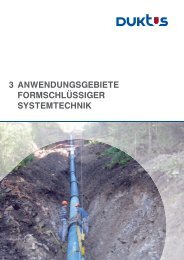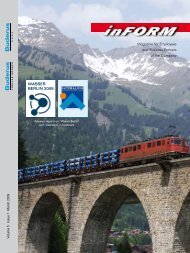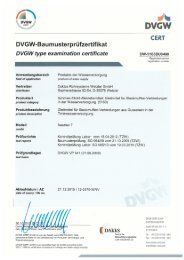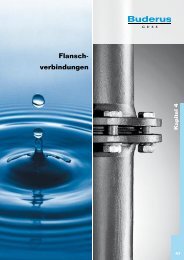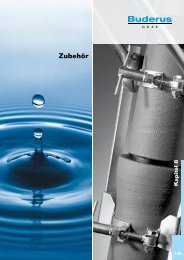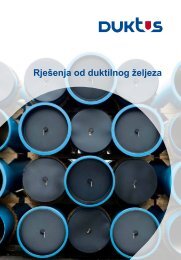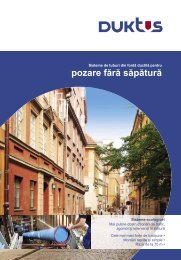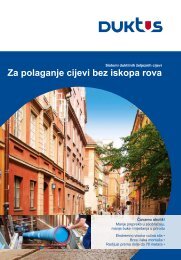Transport pipeline centenary project for the Oststeiermark ... - Duktus
Transport pipeline centenary project for the Oststeiermark ... - Duktus
Transport pipeline centenary project for the Oststeiermark ... - Duktus
You also want an ePaper? Increase the reach of your titles
YUMPU automatically turns print PDFs into web optimized ePapers that Google loves.
F o r w a r d - l o o k i n g p r o j e c t s e c u r e d<br />
F r e s h w a t e r f o r t h e O s t s t e i e r m a r k r e g i o n<br />
<strong>Transport</strong> <strong>pipeline</strong> <strong>centenary</strong> <strong>project</strong> <strong>for</strong> <strong>the</strong> <strong>Oststeiermark</strong> region (Austria)<br />
Although <strong>the</strong> wealth of water enjoyed by Austria is regarded by its population as almost<br />
part of its national identity, <strong>the</strong>re are never<strong>the</strong>less significant regional differences with<br />
regard to <strong>the</strong> reliability of <strong>the</strong> local water supply. When <strong>the</strong> economy in low-moisture<br />
areas grows strongly, <strong>the</strong> water supply is faced with severe challenges.<br />
According to scientists at Joanneum Research<br />
(JR), parts of <strong>the</strong> <strong>Oststeiermark</strong>,<br />
Lower Austria and Burgenland are characterised<br />
by crystalline rocks which break<br />
down into a very fine structure in <strong>the</strong><br />
course of <strong>the</strong> wea<strong>the</strong>ring process, and<br />
are <strong>the</strong>re<strong>for</strong>e not very efficient as aquifers.<br />
The <strong>Oststeiermark</strong> districts of Weiz,<br />
Hartberg, Fürstenfeld, Feldbach and Bad<br />
Radkersburg have been analysed in <strong>the</strong><br />
book “Wasser & Wirtschaft im Klimawandel”<br />
(“Water & Economy in <strong>the</strong> Climate<br />
Change”). With a population of approximately<br />
00,000 inhabitants, booming<br />
<strong>the</strong>rmal spa tourism and a rapidly developing<br />
economy, <strong>the</strong> region can be seen as<br />
a prime example of <strong>the</strong> economic significance<br />
of <strong>the</strong> climate change.<br />
According to <strong>the</strong> study, extensive water<br />
transport <strong>pipeline</strong>s would be <strong>the</strong> most<br />
sensible investment. Water conserva-<br />
tion measures and a revised price policy<br />
have also been examined: “To ensure<br />
good development in <strong>the</strong> future, however,<br />
<strong>the</strong> region needs water from outside.<br />
The <strong>pipeline</strong> costs significantly less<br />
than production stoppages over a period<br />
of only one week”, confirms <strong>the</strong> author,<br />
Franz Prettenthaler. The establishment of<br />
<strong>the</strong> “Wasserverbandes <strong>Transport</strong>leitung<br />
<strong>Oststeiermark</strong>” (“<strong>Oststeiermark</strong> Water<br />
<strong>Transport</strong> Pipeline Association”) on 8th<br />
March 005 in Graz heralded <strong>the</strong> start<br />
of <strong>the</strong> largest-ever <strong>Oststeiermark</strong> water<br />
<strong>project</strong>: <strong>the</strong> construction of a transport<br />
<strong>pipeline</strong> from Graz to Hartberg, via Gleisdorf.<br />
In July 2007, <strong>the</strong> Grazer Stadtwerke<br />
AZ municipal utility company and <strong>the</strong><br />
“Wasserverband <strong>Transport</strong>leitung <strong>Oststeiermark</strong>”<br />
signed <strong>the</strong> water supply<br />
agreement, and on 12th September 2007,<br />
<strong>the</strong> first ground was finally broken <strong>for</strong> this<br />
ambitious <strong>project</strong>.
“TLO” water <strong>pipeline</strong><br />
The <strong>Transport</strong>leitung <strong>Oststeiermark</strong><br />
(TLO) (<strong>Oststeiermark</strong> <strong>Transport</strong><br />
Pipeline) will run from Feldkirchen<br />
via Gleisdorf to Hartberg and, thanks<br />
to this <strong>centenary</strong> <strong>project</strong>, will be capable<br />
of carrying 00 litres of water per<br />
second over a distance of approx. 60<br />
km from Graz to <strong>the</strong> <strong>Oststeiermark</strong><br />
region, <strong>the</strong>reby maximising supply reliability<br />
in <strong>the</strong> area. The objective in a<br />
nutshell: a continuously ensured fresh<br />
water supply <strong>for</strong> <strong>the</strong> population.<br />
As part of <strong>the</strong> Südoststeiermark water<br />
supply network, this major <strong>project</strong> has<br />
been preceded by a number of o<strong>the</strong>r<br />
smaller and larger measures.<br />
This networking of individual water<br />
suppliers will largely ensure <strong>the</strong> water<br />
supply during hot and dry periods or in<br />
emergency and disaster situations.<br />
In <strong>the</strong> tender <strong>for</strong> <strong>the</strong> first contract section<br />
<strong>for</strong> <strong>the</strong> <strong>pipeline</strong> extending over 15<br />
km, <strong>the</strong> proven, excellent quality and<br />
technical laying advantages offered by<br />
<strong>the</strong> ductile cast iron pipes from Tiroler<br />
Röhren- und Metallwerke AG won<br />
out over tough competition from o<strong>the</strong>r<br />
pipe materials. Since <strong>the</strong> groundbreaking<br />
<strong>for</strong> <strong>the</strong> <strong>project</strong>, 15 km of ductile<br />
cast iron pipes (dimensions: DN<br />
400 and DN 500) will have been laid<br />
by spring 008.<br />
The tender process is currently taking<br />
place <strong>for</strong> <strong>the</strong> second contract section<br />
comprising 5 km of piping (dimensions:<br />
DN 00 to DN 500), and <strong>the</strong><br />
Tiroler Röhren- und Metallwerke AG<br />
naturally feels that it has an excellent<br />
chance of being awarded this contract<br />
as well.<br />
Unknown does not mean<br />
uninteresting<br />
The Austrian <strong>Oststeiermark</strong> region<br />
Still a secret tip<br />
Where exactly is <strong>the</strong> <strong>Oststeiermark</strong> region?<br />
To be precise: In Sou<strong>the</strong>ast Austria<br />
as part of <strong>the</strong> federal state of Steiermark,<br />
to <strong>the</strong> east of <strong>the</strong> Mur River and south of<br />
<strong>the</strong> Wechsel and <strong>the</strong> Fischbacher Alps. Or<br />
in o<strong>the</strong>r words: a little out of <strong>the</strong> way. The<br />
main tourist routes run past it to Vienna/<br />
Hungary on one side, and to Tyrol/Italy<br />
on <strong>the</strong> o<strong>the</strong>r. The landscape is, <strong>the</strong>re<strong>for</strong>e,<br />
still shaped today by <strong>the</strong> people who live<br />
<strong>the</strong>re, and not by tourism. Rugged mountains,<br />
wide plains and gently rolling hills<br />
all lie close toge<strong>the</strong>r within a small area.<br />
Due to <strong>the</strong> proximity of Slovenia, <strong>the</strong> local<br />
inhabitants are said to have a certain<br />
Mediterranean flair about <strong>the</strong>m, friendly<br />
and jovial, a blend of Central and Sou<strong>the</strong>ast<br />
European. Tourism naturally plays a<br />
certain role in <strong>the</strong> <strong>Oststeiermark</strong> region,<br />
although <strong>the</strong>re are no real major attractions<br />
to be found. Large, palatial hotels are<br />
rare. Instead, <strong>the</strong>re are many private lodgings<br />
and farms situated amongst <strong>the</strong> relatively<br />
intact nature, toge<strong>the</strong>r with a host of<br />
opportunities and facilities <strong>for</strong> sports. The<br />
tourism region of <strong>Oststeiermark</strong> encompasses<br />
<strong>the</strong> Teichalm-Sommeralm Alpine<br />
pasture area, which boasts <strong>the</strong> largest Alpine<br />
pasture area in Europe; Joglland, a<br />
traditional summer vacation destination;<br />
Wechselland with its “Naturbiotischen<br />
Zentrum” („Natural Biotic Centre“); <strong>the</strong><br />
Hartbergerland area around <strong>the</strong> district<br />
capital; Apfelland region around Stubenbergsee<br />
lake (<strong>the</strong> largest fruit-growing region<br />
in Austria); <strong>the</strong> Pöllauer Tal Nature<br />
Park; <strong>the</strong> Weiz/Gleisdorf region, and <strong>the</strong><br />
<strong>the</strong>rmal spa resort at Bad Waltersdorf. In<br />
particular, <strong>the</strong>re is a broad and varied<br />
range of <strong>the</strong>rmal spas in <strong>the</strong> region. The<br />
hot, curative waters come from depths of<br />
up to 10,000 ft. below <strong>the</strong> ground.<br />
The <strong>Oststeiermark</strong> region, dotted with castles<br />
and <strong>for</strong>tresses, is an ancient land on<br />
<strong>the</strong> <strong>for</strong>mer eastern border of <strong>the</strong> Christian<br />
West. In addition to Catholicism, many<br />
pagan customs have also survived. From<br />
<strong>the</strong> 1700 metre (5,500 ft.) high alpine<br />
mountains down to <strong>the</strong> Pannonian Plain,<br />
<strong>the</strong> <strong>Oststeiermark</strong> offers a wealth of varied<br />
landscapes. The land has been <strong>for</strong>med by<br />
centuries of history and culture, as well as<br />
by its people, who cultivate and manage<br />
<strong>the</strong> orchards, <strong>for</strong>ests and vineyards largely<br />
in harmony with <strong>the</strong> landscape. Peaches<br />
also flourish in <strong>the</strong> mild local climate. From<br />
this understanding of nature, it is only a<br />
small step to <strong>the</strong> modern side of <strong>the</strong> <strong>Oststeiermark</strong>:<br />
It is in <strong>the</strong> process of becoming<br />
a model region <strong>for</strong> renewable energies<br />
and energy efficiency. Pioneering and<br />
development work in this field has been<br />
going on here <strong>for</strong> years amongst <strong>the</strong> 192<br />
local <strong>Oststeiermark</strong> communities. The region<br />
now intends to improve <strong>the</strong> way it<br />
presents itself publicly on <strong>the</strong> subject and<br />
combine economic added value with an<br />
ecologically and socially sustainable attitude.<br />
The people of <strong>Oststeiermark</strong> want<br />
to utilise <strong>the</strong> energy generation options<br />
offered by <strong>the</strong> country itself – which can<br />
also be see as a <strong>for</strong>m of commitment to<br />
<strong>the</strong>ir homeland.



